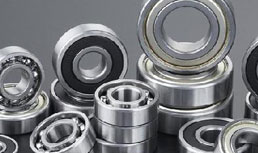Shaft part is one of the typical parts in the machine. It is mainly used to support the transmission parts, transmission torque and bearing load. The shaft part is a rotating body part, whose length is larger than the diameter, and is generally composed of an outer cylinder, a conical surface, an inner hole and a thread of the concentric shaft and a corresponding end face. According to the different structure shape, the shaft parts can be divided into the optical axis, the stepped shaft, the hollow shaft and the crankshaft.
The length to diameter ratio of less than 5 is called the short axis, and greater than 20 is called the slender shaft, and most of the shaft is between the two.
Shaft bearing support, and bearing with the shaft section called the shaft. The journal is the axis of the assembly base, their precision and surface quality generally higher, according to its general technical requirements and working conditions of the main function of shaft making, usually has the following items:
(a) shaft parts size precision processing technology -
In order to determine the position of the shaft, the shaft neck, which plays a supporting role, usually requires a higher dimensional accuracy (IT5~IT7). The general requirement for the accuracy of the shaft neck of assembly drive parts is lower (IT6~IT9).
(two) shaft parts processing precision -
The geometry precision of shaft parts is mainly refers to the journal, the outer cone, the cone Morse roundness, cylindricity, general tolerances should be restricted in size within the tolerance range. On the internal and external surfaces with high accuracy, the allowable deviation should be marked on the drawing.
(three) shaft parts processing - mutual position precision of the
The position accuracy of shaft parts is mainly determined by the position and function of the shaft in the machine. It is usually required to ensure that the shaft neck of the assembly drive part is required for the coaxial degree of the supporting shaft, otherwise it will affect the transmission accuracy of the transmission parts (gear, etc.) and generate noise. General accuracy of the shaft, the shaft section of the supporting shaft in the radial direction of the radial generally 0.01~0.03mm, high precision axis (such as the spindle) is usually 0.001~0.005mm.
(four) shaft parts processing - surface roughness of
Generally, the surface roughness of the shaft diameter matched with the transmission parts is Ra2.5~0.63μ m, the surface roughness of the supporting shaft matched with the bearing is Ra0.63~0.16μ M.
Shaft parts processing, two shaft parts and blank material
(a) shaft blank
Shaft parts can be used in accordance with the requirements of the production type, equipment conditions and structure, the selection of bar material, forging and other forms of blank. The outer diameter of the shaft is similar, generally bar; the outer diameter of a big difference between the stepped shaft or shaft, often used in forging, thus saving the material and reducing the workload of the machining, but also improve the mechanical properties.
According to the different scale of production, there are two kinds of forging methods, free forging and die forging. Small batch production of free forging, a large number of mass production using die forging.
(two) shaft material
Shaft parts should according to different working conditions and requirements of the choice of different materials and heat treatment with different specifications (such as quenching, normalizing, quenching, etc.) in order to obtain the strength, toughness and wear resistance of certain.
45 steel is commonly used in shaft parts, it is cheap after quenching and tempering (or normalizing), can obtain better cutting performance, but also can obtain high strength and toughness and other mechanical properties after quenching, surface hardness of up to 45~52HRC.
40Cr and other alloy structural steel is suitable for the high precision and high speed shaft parts, this kind of steel after quenching and tempering, has good comprehensive mechanical properties.
GCr15 bearing steel and spring steel 65Mn, after quenching and tempering and surface high frequency quenching, the surface hardness of up to 50~58HRC, and has a high fatigue resistance and good wear resistance, can be manufactured with higher accuracy of the shaft.
Precision machine tool spindle (such as grinding wheel spindle coordinate boring machine) can be used 38CrMoAIA steel nitride. After tempering and surface nitriding, the steel is not only able to obtain a high surface hardness, but also can maintain a soft core, so the impact toughness is good. Compared with carburizing and quenching steel, it has a very small heat treatment deformation, higher hardness characteristics. A, shaft parts function, structure characteristics and technical requirements of
Shaft part is one of the typical parts which are often encountered in the machine. It is mainly used to support the transmission parts, transmission torque and bearing load. The shaft part is a rotating body part, whose length is larger than the diameter, and is generally composed of an outer cylinder, a conical surface, an inner hole and a thread of the concentric shaft and a corresponding end face. According to the different structure shape, the shaft parts can be divided into the optical axis, the stepped shaft, the hollow shaft and the crankshaft.
The length to diameter ratio of less than 5 is called the short axis, and greater than 20 is called the slender shaft, and most of the shaft is between the two.
Shaft bearing support, and bearing with the shaft section called the shaft. The journal is the axis of the assembly base, their precision and surface quality generally higher, according to its general technical requirements and working conditions of the main function of shaft making, usually has the following items:
(a) the dimensional accuracy of
In order to determine the position of the shaft, the shaft neck, which plays a supporting role, usually requires a higher dimensional accuracy (IT5~IT7). The general requirement for the accuracy of the shaft neck of assembly drive parts is lower (IT6~IT9).
(two) the geometry precision of

Tel:+86-635-2856888
Max:+86-635-2856388
Mobile:+86-15206522666 +86-13906352606
E-mail:yxhtbearing@126.com
Manager:Manager Meng
Address:Industrial park Yandian Linqing Shandong




